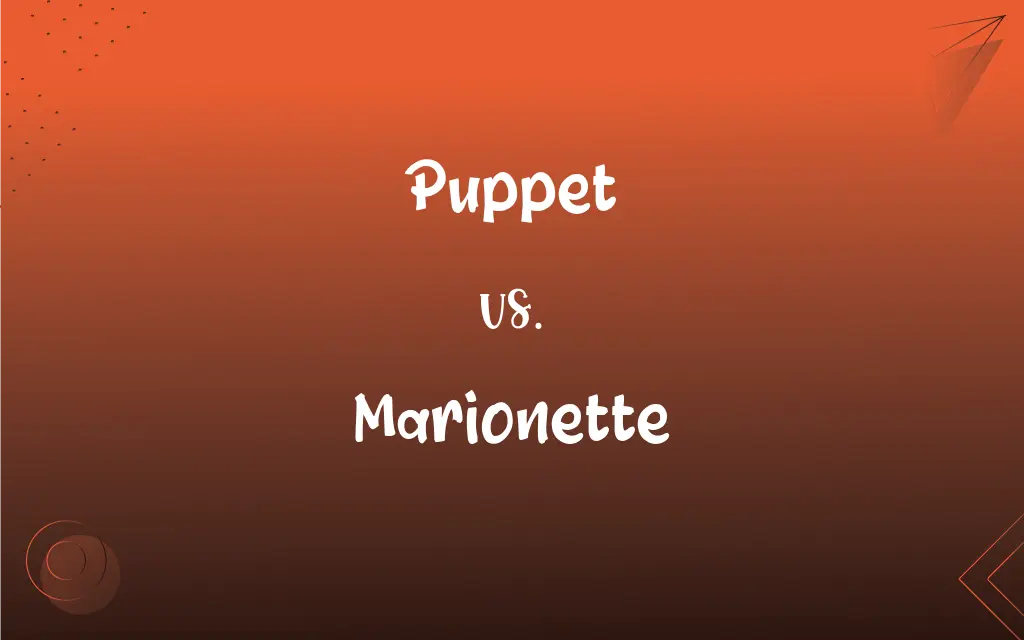Puppet vs. Marionette: What's the Difference?
Edited by Aimie Carlson || By Harlon Moss || Published on December 7, 2023
A puppet is a figure moved by a person's hands or strings for performance, while a marionette is a specific type of puppet controlled from above using strings or wires.

Key Differences
Puppets are figures used in performance arts, controlled by an individual using hands, rods, or strings. Marionettes, a subset of puppets, are specifically controlled by strings or wires attached to a control bar or rods, manipulated from above.
Puppets can take various forms, including hand puppets, rod puppets, and shadow puppets, each operated differently. Marionettes are recognized for their string operation, allowing complex movements and realistic animation.
The control of puppets depends on the type: hand puppets are controlled by the hand inside them, while rod puppets use rods attached to various parts. Marionettes require skillful manipulation of the strings or wires to create lifelike movements.
Puppets have a broad range of cultural significance and styles across the world, often used in storytelling and entertainment. Marionettes are often associated with intricate craftsmanship and are used in specialized puppetry performances requiring specific skills.
In puppetry, the term 'puppet' is a general term encompassing various forms, including marionettes. Marionettes, while a type of puppet, have distinct characteristics, notably their string-based manipulation.
ADVERTISEMENT
Comparison Chart
Control Method
Varies (hands, rods, strings)
Controlled by strings or wires from above
Types
Includes hand, rod, and shadow puppets
A specific type of string puppet
Movement
Depends on puppet type
Lifelike, complex movements with strings
Craftsmanship
Varies widely
Often intricate, detailed craftsmanship
Cultural Significance
Broad, varies across cultures
Specific to skilled puppetry arts
ADVERTISEMENT
Puppet and Marionette Definitions
Puppet
Puppets can be operated by hands, rods, or strings.
She skillfully maneuvered the rod puppet to mimic walking.
Marionette
A marionette is a puppet controlled by strings or wires from above.
The marionette's dance was controlled by a skilled puppeteer.
Puppet
Puppets are used in various forms of traditional and modern storytelling.
The puppet theater presents tales from folklore.
Marionette
Marionettes are often associated with intricate craftsmanship.
Each marionette was handcrafted with remarkable detail.
Puppet
Puppets are often used in education and entertainment.
The puppet was used to teach children about wildlife conservation.
Marionette
Marionettes require skillful manipulation of strings by the puppeteer.
He practiced for hours to perfect the marionette's movements.
Puppet
A puppet is a movable figure controlled by a person for performance.
The children were delighted by the puppet show.
Marionette
Marionettes allow for complex and lifelike movements.
The marionette moved as if it were truly alive.
Puppet
Puppet designs vary greatly across different cultures.
His collection includes puppets from all over the world.
Marionette
Marionettes are used in specialized performances and puppetry arts.
The theater is renowned for its exceptional marionette shows.
Puppet
A small figure of a person or animal, having a cloth body and hollow head, designed to be fitted over and manipulated by the hand.
Marionette
A jointed puppet manipulated from above by strings or wires attached to its limbs.
Puppet
A figure having jointed parts animated from above by strings or wires; a marionette.
Marionette
A puppet, usually made of wood, which is animated by the pulling of strings.
Marionette
(obsolete) The buffel duck.
Marionette
(transitive) To control (somebody) as if they were a puppet; to manipulate.
Marionette
A puppet moved by strings, as in a puppet show.
Marionette
The buffel duck.
Marionette
A small figure of a person operated from above with strings by a puppeteer
FAQs
How are puppets different from marionettes?
Puppets include various forms of controlled figures, while marionettes are specifically string-controlled from above.
What materials are used to make marionettes?
Marionettes are often made of wood, cloth, and other materials with intricate craftsmanship.
How are marionette strings manipulated?
Marionette strings are manipulated using a control bar or rods to create movement.
Can puppets have moving parts?
Yes, some puppets, especially marionettes, have moving parts for realistic animation.
Do all puppets use strings?
Not all puppets use strings; some use hands or rods for control.
Are marionettes used in modern performances?
Yes, marionettes are used in both traditional and modern puppetry arts.
Can puppets be used for education?
Yes, puppets are commonly used in educational settings for interactive learning.
Are marionettes considered puppets?
Yes, marionettes are a specific type of puppet.
What is a puppet?
A puppet is a movable figure used in performance arts, controlled by hands, rods, or strings.
What is a marionette?
A marionette is a type of puppet controlled from above using strings or wires.
What is the cultural significance of puppets?
Puppets have diverse cultural significance worldwide, often used in storytelling and traditional arts.
Can marionettes depict realistic human movements?
Yes, marionettes can mimic realistic human movements with skilled control.
How long has puppetry been around?
Puppetry is an ancient art form, with a history spanning thousands of years.
Are there different styles of puppets across cultures?
Yes, different cultures have unique styles and types of puppets.
What is the purpose of a rod puppet?
Rod puppets are controlled using rods attached to their limbs for movement.
Do marionettes require special skills to operate?
Yes, operating marionettes skillfully requires practice and dexterity.
Can marionettes be automated?
Traditional marionettes are manually controlled, but some modern versions can be automated.
What is a hand puppet?
A hand puppet is a type of puppet that is controlled by inserting a hand inside it.
Are marionettes common in children's shows?
Marionettes are used in children's shows, though they require skilled puppeteers.
Do puppeteers often voice their puppets?
Yes, puppeteers frequently provide voices and personalities for their puppets.
About Author
Written by
Harlon MossHarlon is a seasoned quality moderator and accomplished content writer for Difference Wiki. An alumnus of the prestigious University of California, he earned his degree in Computer Science. Leveraging his academic background, Harlon brings a meticulous and informed perspective to his work, ensuring content accuracy and excellence.
Edited by
Aimie CarlsonAimie Carlson, holding a master's degree in English literature, is a fervent English language enthusiast. She lends her writing talents to Difference Wiki, a prominent website that specializes in comparisons, offering readers insightful analyses that both captivate and inform.






































































